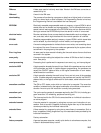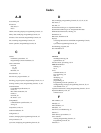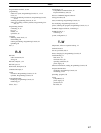
Glossary
112
set The process of turning a bit or signal ON.
set value The value from which a decrementing counter starts counting down or to which
an incrementing counter counts up (i.e., the maximum count), or the time from
which or for which a timer starts timing. Set value is abbreviated SV.
shift input signal An input signal whose OFF to ON transition causes data to be shifted one bit.
shift register One or more words in which data is shifted a specified number of units to the right
or left in bit, digit, or word units. In a rotate register, data shifted out one end is
shifted back into the other end. In other shift registers, new data (either specified
data, zero(s) or one(s)) is shifted into one end and the data shifted out at the oth-
er end is lost.
signed binary A binary value that is stored in memory along with a bit that indicates whether the
value is positive or negative.
signed decimal One-word signed hexadecimal values stored in the two’s complement format
can be displayed at the Programming Console as decimal values from –32,768
to 32,767.
software error An error that originates in a software program.
software protect A means of protecting data from being changed that uses software as opposed
to a physical switch or other hardware setting.
source (word) The location from which data is taken for use in an instruction, as opposed to the
location to which the result of an instruction is to be written. The latter is called
the destination.
special instruction An instruction input with a function code that handles data processing opera-
tions within ladder diagrams, as opposed to a basic instruction, which makes up
the fundamental portion of a ladder diagram.
SR area A memory area containing flags and other bits/words with specific functions.
SSS See SYSMAC Support Software.
store The process of recording a program written into a display buffer permanently in
memory.
subroutine A group of instructions placed separate from the main program and executed
only when called from the main program or activated by an interrupt.
subroutine number A definer used to identify the subroutine that a subroutine call or interrupt acti-
vates.
subtract count input An input signal used to decrement a counter when the signal changes from OFF
to ON.
SV See set value.
switching capacity The maximum voltage/current that a relay can safely switch on and off.
synchronous execution Execution of programs and servicing operations in which program execution
and servicing are synchronized so that all servicing operations are executed
each time the programs are executed.
syntax The form of a program statement (as opposed to its meaning).
syntax error An error in the way in which a program is written. Syntax errors can include
‘spelling’ mistakes (i.e., a function code that does not exist), mistakes in specify-
ing operands within acceptable parameters (e.g., specifying read-only bits as a
destination), and mistakes in actual application of instructions (e.g., a call to a
subroutine that does not exist).


















